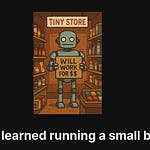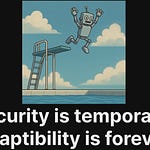(Like this article? Read more Wednesday Wisdom! No time to read? No worries! This article is also available as a podcast).
If you are like me, you are regularly experiencing the following: It is Friday afternoon 2pm, you are still in the office expected (and expecting) to do real work, but the only thing you seem to be able to do is click between Slack, email, and then back to Slack. You are busy clicking, but nothing is happening. Maybe you are also familiar with this one: It is Wednesday evening, you are sitting at home with a todo list that is as long as your arm. But, instead of diligently attacking these todo items, you spend the entire evening doomscrolling or clicking on one YouTube video after another.
Welcome to the slump!
I have been wondering about the miracle of human motivation for some time now. How come that sometimes we are full of energy and we can’t wait to get going on something, whereas at other times we cannot muster the energy to do anything at all, no matter how small. It is a question with a complicated and multi-faceted answer.
One of the reasons for my interest in this topic is that I suffer from the slump regularly. Another reason is that I have seen friends get laid off because they were impacted by the slump for a significant period of time, which made them miss important performance targets. The slump can have serious consequences and it hits everyone from time to time, so it is definitely in our interest to have good strategies for dealing with it. Over the years, I have figured out a few things that work for me in overcoming the slump. I am not at all claiming that these strategies are universal and will work for you too, but I will happily share them. Try them out, improve upon them, and keep what works. Or, as Monty Python so aptly put it: Adopt, adapt, improve (motto of the round table).
Let me start by classifying my slumps as minor, medium, and major.
Minor slumps are typically the result of tiredness. I experienced one of these last Friday; I had pulled a number of intense 10+ hour work days that week already and come Friday I was just exhausted. And when I am exhausted, I find it hard to concentrate on anything that is even slightly complicated. That slump lasted well into the evening and was even impacting me on Saturday morning. What to do?
For minor slumps in the office I keep a list of action items around that cost me little or no effort, but that still need to get done. These items are the tech equivalent of rearranging my sock drawer by color; examples are fixing up comments in the code I wrote earlier that week or reviewing a recent post-mortem. This is the kind of work that I do not waste my most productive hours on because these are better spent doing things that are difficult and that require significant focus and brainpower. In other words: My strategy is to match the task to the energy level and to make sure I have a stack of action items ready to go for every energy level. With that approach, even my low-energy afternoons are spent at least somewhat productively.
Here is a strategy that doesn’t work: Relying on willpower. There is a significant school of thought that says that, in a slump, you should just “harden the fuck up” and get to it. That strategy, my friends, does not work. Willpower is a limited resource and if it’s gone, it’s gone for a while and cannot be used until it replenishes. When there is enough willpower in the tank, it works well and you will know when this happens because you just “get to it” even though you might not feel like it. But for most (minor) slumps, you are just out of energy and there is no willpower left in the tank. What you need to do is relax and eventually, magically, your willpower reservoir fills up again.
Keeping around a list of straightforward tasks is a simple way to deal with minor slumps at work. However, if you are suffering from a minor slump at home, I would suggest an even simpler approach: Just do nothing for an evening 🙂. Click that YouTube video, cycle from a book to Instagram to a game on your iPad and back to YouTube again. Sure, it is not very productive, but who said that you need to be productive in your private time? I spend many a weekend just growing a beard (not a lot of effort) and that allows me to recover so that I am all fired up and ready to go on Monday morning.
Medium slumps are much harder to deal with. A medium slump is characterized by being low energy for days, if not weeks. I have gone through a number of these in my career and each of them was prompted by a slightly different root cause. My first medium slump was two years into my first job, when I was hit by a bit of a depression caused by the realization that this (in other words: A job) was what I would would be doing for the next forty years. If you are only 24 years old, that seems like an unimaginably long time to be doing only moderately interesting work while drinking bad coffee and being in too many meetings from Monday to Friday dawn to dusk. I overcame that slump by switching to a more exciting job and by (after some time) reconciling myself with my fate; eventually I “hardened the fuck up” (it does work sometimes 🙂). The strategy for this particular slump was: Do a decent root cause analysis of what is going on and maybe talk to some people.
Another possible root cause for a medium slump is that you are faced with a problem that you don’t know how to approach. I once suffered from this when I took a contract to design some system that I had no idea how to build. I went to the meetings, promised deliverables, but then did … nothing, because I just didn’t know where to start. Looking back, that was clearly ridiculous because the system wasn’t that complicated, but heh, that’s what 30 years more experience does for you. The strategy I developed from that experience is called “just start”.
If I need to do something and I don’t have a good idea on how to do it, I just start by implementing my bad ideas and accepting that they are bad (or at best: Suboptimal). This leads to throwaway work, but at least I am doing something and while I am doing something, something else is happening too: I am learning. For these types of medium slumps the root cause is that I don’t understand the problem and solution space deeply enough to formulate a plan of attack. So I need to investigate these spaces, but the way my brain works is that I only learn when I am faced with tangible problems that I need to solve. Implementing my bad ideas is a great way for me to start untangling the mess in my head. You might argue that starting to implement bad ideas is not very efficient or very effective, but I would counter that by remarking upon the fact that just sitting there not knowing where to start and what to do is not very productive either. With the “just start” strategy, at least I am doing something.
Sometimes what I end up with is good enough and that then goes to production. If you have dealt with any of my “good enough for government work”, I apologize.
Which leaves us with the major slumps. Fortunately, I have experienced only one major slump in my life. This was at a time when two major life events (a divorce and the passing away of my mother) coincided with an economic crisis that thwarted a plan that I had invested a lot of hope in. For months I could not get anything done and my todo list was getting longer and longer. The problem with a todo list that long is that it becomes its own source of paralysis, as there are inevitably more and less important things on there as well as bigger and smaller ones. In that situation, you cannot get yourself to get going on the smaller and maybe less important things because then you feel guilty that you are not working on the more important things. The result of all of this is that nothing happens; the list just gets longer with the passing of time.
I realized that I needed a lot of time to recover and eventually I settled on a strategy that contained three elements. The first one is similar to my advice for overcoming minor slumps, but at a different scale: Match the energy to the task. In order to conserve energy, I took a job as a Java programmer that was significantly below my knowledge and skills, thereby ensuring that I would get a paycheck but without spending too much valuable energy on getting it. The second element was attacking my todo list. I made a promise with myself that I would do three things from the list every day, no matter how small or unimportant. I convinced myself that if I had done three things, I would not have to feel guilty, not even if these three things were not important, because the “contract” said that I just needed to do three things and it didn’t specify how important they had to be. This worked tremendously well because there were many small and unimportant items on the list that really did not take more than five minutes to complete. By “just starting” on the list I created a positive feedback loop that eventually led me to get going on the bigger and more important things as well. The third element of my strategy was to plan a sabbatical, thereby giving myself the gift of time in order to heal.
As I wrote at the start of this article: I am not claiming that these are universal strategies that will work for everyone in every conceivable circumstance. You and I are both unique and uniquely different too. But, it worked for me and maybe some of these strategies will work for you too! Adopt, adapt, improve!












